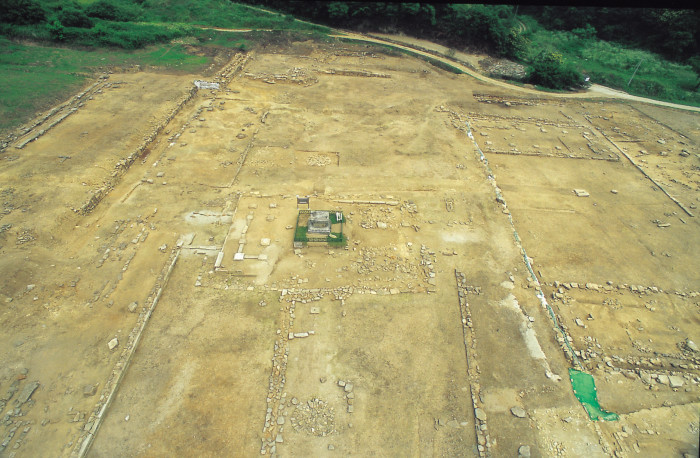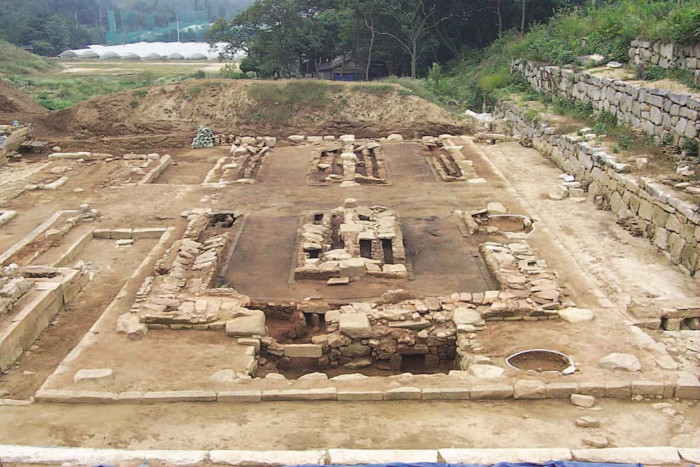GyeongGi Cultural Properties
6. The Beauty of Architecture of Goryeo
the Space of Emptiness and the Way of Fullness
Goryeo accomplished the culture full of diversity and dynamics. The open mindset and aesthetics of the people of Goryeo are still remaining with us in the form of their heritage and relics. Particularly unequaled examples are the Godalsa Temple, where the Zen monks trained, Hoeamsa Temple, which was sponsored by the royal court, and Hyeeumwon, which played the role of a state-run hotel. The sites where these three structures were standing, along with their records, have been excavated, which allows us to closely look into the era and its Buddhist temples.
They are all built on the gentle slope surrounded by the low hillside and stream. If the Hoeamsa Temple was constructed to form an arrangement creating tension and depth to the place, Godalsa Temple naturally harmonized with its surroundings and added an expanded feeling to the neighboring space. Hyeeumwon, on the other hand, combined the space for Buddhist services with the accommodation, imposing the hierarchical order to the space with the temporary palace in the rear.
Godalsa Temple Site, Yeoju / Provided by Gyeonggi Institute of Cultural Properties |
Godalsa Temple Site, Yeoju, is where the representative Zen temple of the Goryeo Period was standing on the riverside of Namhangang River. From the late Silla to the early Goryeo Period, a number of Zen temples were built along Namhangang River, where the exchanges between not only monks but also artisans and travelers took place through land and water routes, resulting in formation of various venues. Walk along the side of where the main building was standing and enter the grand yard, and you will see the Buddha hall and the pagoda. You can also look around the living quarters you have just passed by. If you advance further, you will reach the monument that celebrates the stay of great monks, stele and stupa. Godalsa Temple Site shows a high level of architectural art as it offers the natural flow of space with its stupa, pagoda and stone lantern in an empty space.
Seoseungdang Site of Hoeamsa Temple Site, Yangju / Provided by Gyeonggi Institute of Cultural Properties
|
Hoeamsa Temple Site, Yangju, boasts an orderly arrangement and a large scale, almost comparable to a palace, as described by the scholar Yi Saek of the late Goryeo Period, “the buildings amount to 262 kan (one kan refers to the distance between two columns).” There were many structures in the site with diverse functions, including bangjang, the quarter of a head monk, beopdang, the hall for Buddhist services, seungdang, the meditation hall, living quarters of monks, kitchen, warehouse and toilet. These buildings were densely located next to each other, yet formed a harmonious inner and outer space as they were built following the flow of light and water. They were also equipped with an unprecedented, unique ondol (heated floor) system.
Located on the way from Gaegyeong (present-day Gaeseong) to Namgyeong (present-day Seoul), Hyeeumwon Site, Paju, has the traces of several layers of gate houses, where many travelers could get some rest or spend a night, in front of the hall for Buddhist services. This arrangement of buildings is suitable for their function but looks rather simple. What added a charming breath to this composition is the water, the valley stream from its backyard and the dropping water from the building rooftops, flowing between the structures, staying a while in the pond before flowing out again to the sides, the stairs, and the terrace of the buildings. This all added the vertical variations to the space, creating the horizontal landscape as a harmonious beauty completed from the outstanding technique and excellent architectural sense without resisting nature.
The architecture of the Goryeo Period was composed with originality according to the location, conditions and function. All the structures carry their own spectacular dynamics, declaring the intention to ‘empty and fill’ the space with nature and humankind, yards and buildings, and people and roadways. / ◎ Lee Seung-yeon(Senior Researcher of Gyeonggi Institute of Cultural Properties)
<Copyright(c)2002 GGC All rights reserved.>

